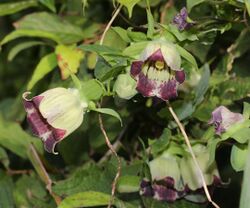Biology:Codonopsis lanceolata
| Codonopsis lanceolata | |
|---|---|

| |
| Scientific classification | |
| Kingdom: | Plantae |
| Clade: | Tracheophytes |
| Clade: | Angiosperms |
| Clade: | Eudicots |
| Clade: | Asterids |
| Order: | Asterales |
| Family: | Campanulaceae |
| Genus: | Codonopsis |
| Species: | C. lanceolata
|
| Binomial name | |
| Codonopsis lanceolata (Siebold & Zucc.) Trautv.
| |
Codonopsis lanceolata, also called deodeok or lance asiabell,[1] is a flowering plant native to East Asia (China , Japan , Korea, and the Russia n Far East). It is a variety of bonnet bellflower.
Description
It is a hardy perennial climber that grows up to 1.5 m tall. It has bell-shaped flowers that are purple inside and bloom from August to September. The seeds ripen from September to October. The flowers are hermaphroditic and are pollinated by bees and wasps.[2]
Cultivation
It grows in moist areas in woodland on low hills or mountains at an elevation of 200–1600 m. The plant grows best in light and medium-well drained soils with plenty of moisture with a neutral to acidic pH and in full sun to semi-shade.[3]
Slugs and snails eat young shoots.
The plant is propagated by seed that are surface-sown onto ericaceous compost. Division is also possible, although great care must be taken as the plant is intolerant of root disturbance.
The plant is grown commercially in Hoengseong County, Gangwon Province, South Korea, where it is an important part of the local agriculture. However, many South Koreans grow a small amount in personal gardens.
Uses
Culinary
Korea
The roots of deodeok (더덕), are used in Korean cuisine. They are eaten both fresh and cooked. Grilled marinated deodeok, called deodeok-gui, is often served as a vegetarian main dish. Deodeok can be pan-fried as jeon, pickled as kimchi, or used in fusion dishes such as salads.[citation needed]
Deodeok salad with yuja dressing
Medicinal
Codonopsis lanceolata is used in Korean and Chinese traditional medicine.[4]
Etymology
The specific epithet of lanceolata refers to the plant's lance-shaped leaves. The genus name, Codonopsis, is derived from the Greek κώδων (kodon) "bell" and ὄψις (opsis) "eye, to see", referring to the shape of the petals of the flower.[5]
References
- ↑ English Names for Korean Native Plants. Pocheon: Korea National Arboretum. 2015. pp. 417. ISBN 978-89-97450-98-5. http://www.forest.go.kr/kna/special/download/English_Names_for_Korean_Native_Plants.pdf. Retrieved 6 December 2016.
- ↑ "Codonopsis lanceolata Todok PFAF Plant Database". https://pfaf.org/user/plant.aspx?latinname=Codonopsis+lanceolata.
- ↑ "Night Temperature Affects the Growth, Metabolism, and Photosynthetic Gene Expression in Astragalus membranaceus and Codonopsis lanceolata Plug Seedlings". Plants 8 (10). 10 October 2019. doi:10.3390/plants8100407. ISSN 2223-7747. PMC 6843391. http://dx.doi.org/10.3390/plants8100407.
- ↑ "Codonopsis: Medicine and Food". http://www.itmonline.org/arts/codonopsis.htm.
- ↑ "Codonopsis lanceolata". https://www.missouribotanicalgarden.org/PlantFinder/PlantFinderDetails.aspx?taxonid=278856.
External links
Wikidata ☰ Q1040125 entry
 |







